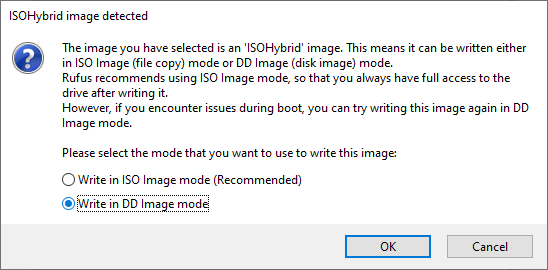
- #WRITE ISO TO USB LINUX HOW TO#
- #WRITE ISO TO USB LINUX INSTALL#
- #WRITE ISO TO USB LINUX SOFTWARE#
- #WRITE ISO TO USB LINUX PC#
- #WRITE ISO TO USB LINUX DOWNLOAD#
#WRITE ISO TO USB LINUX INSTALL#
dd or cp or cat can be used, but they are not safe because they do what you tell them to do without any question, and a minor typing error is enough to overwrite a drive with valuable data.įortunately there are also safer text mode tools, but you have to install them. There are built-in text mode tools, that you can run from a text screen or a terminal window.
#WRITE ISO TO USB LINUX HOW TO#
How to create a bootable Ubuntu USB flash drive from terminal?
#WRITE ISO TO USB LINUX SOFTWARE#
You don't need to install any third party software to make a Linux USB flash drive. This method will work for any Linux distribution, not only Ubuntu.

Now your Ubuntu USB flash drive will boot and you can install it.
#WRITE ISO TO USB LINUX PC#
Reboot your PC and change the boot order in BIOS to allow booting from a USB drive. Then go into the renamed folder and rename the file isolinux.cfg to syslinux.cfg. Navigate to the /media/xxx mount folder and rename the isolinux directory to syslinux. Run the below commands: sudo apt-get install syslinux mtools My USB partition is /dev/sdd1 enter lsblk to see what's yours. Next, you need the ldlinux.sys file in your USB flash drive to make the USB bootable. Let's assume that it was mounted in /media/xxx/.Ĭopy all files from /media/iso/ to your mounted USB flash drive by running the below command (make sure to include the dot): cp -a /media/iso/. Your drive may be automatically mounted inside /media/.

Sudo mount -o loop /path/to/ubuntu.iso /media/iso Then mount the ubuntu.iso file with the below commands in terminal: sudo mkdir /media/iso/ Place the ubuntu.iso file in any hard disk partition. So the target needs to be /dev/sdc and not /dev/sdc For me it was /dev/sdb.Ĭreating a bootable Ubuntu USB flash drive from terminal This method is fast and has never failed me.ĮDIT: for those on a Mac ending up here, use lowercase for bs=4m: sudo dd if=inputfile.img of=/dev/disk bs=4m & syncĮDIT: If USB drive does not boot (this happened to me), it is because the target is a particular partition on the drive instead of the drive. Where input.iso is the input file, and /dev/sd is the USB device you're writing to (run lsblk to see all drives to find out what is for your USB). Then, next (this is a destructive command and wipes the entire USB drive with the contents of the iso, so be careful): sudo dd bs=4M if=path/to/input.iso of=/dev/sd conv=fdatasync status=progress ├─sdb1 8:17 1 1.6G 0 part /media/username/usb volume name It will look something like sdb 8:16 1 14.9G 0 disk Provide a downloaded Ubuntu ISO file, connect a USB drive, and the tool will create a bootable Ubuntu USB drive for you.Where is a letter followed by a number, look it up by running lsblk. Just open the Dash and search for the “Startup Disk Creator” application, which is included with Ubuntu. If you’re already using Ubuntu, you don’t need to do this from Windows. How to Create a Bootable USB Drive on Ubuntu You can also take it to another computer and boot Ubuntu from the USB drive on that computer. Next, restart your computer and boot from the USB drive using these instructions. You can click “Close” to close Rufus when it’s done. Rufus will create the bootable USB drive. RELATED: How to Boot Your Computer From a Disc or USB Drive (If you forgot to back up your data, click “Cancel”, back up the data on the USB drive, and then run Rufus again.) Click “OK” to continue if the drive has no important data on it. You’ll be warned that all data on the USB drive will be erased. Just select the default option-“Write in ISO Image Mode (Recommended)”-and click “OK”. Rufus will ask how you want to write the image. There are many tools that can do this job for you, but we recommend a free program called Rufus-it’s faster and more reliable than many of the other tools you’ll see recommended, including UNetbootin. How to Create a Bootable USB Drive on Windows For installing Linux to your PC, this is fine-but if you want a live USB that keeps your changes so you can use it regularly on different computers, you’ll want to check out these instructions instead. When you run it, none of your chances (like installed programs or created files) will be saved for the next time you run it. NOTE: This process creates a traditional live USB drive.

RELATED: How to Create a Live Ubuntu USB Drive With Persistent Storage If you’re not sure which one to download, we recommend the LTS release.īelow, we’ll show you how to turn this ISO into a bootable flash drive on both Windows or an existing Linux system.
#WRITE ISO TO USB LINUX DOWNLOAD#
Head to Ubuntu’s download page and download the version of Ubuntu you want-either the stable “Long Term Service” release or the current release. You’ll need to download an ISO file to do this-we’re going to use Ubuntu in our example, but this should work for quite a few different Linux distributions.


 0 kommentar(er)
0 kommentar(er)
